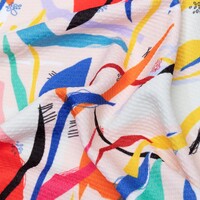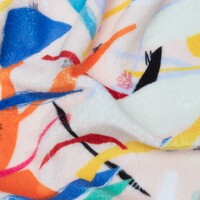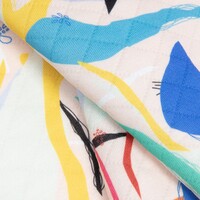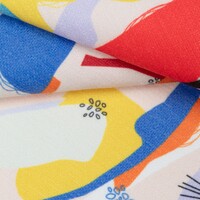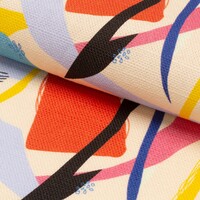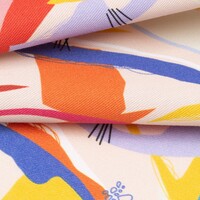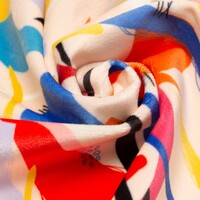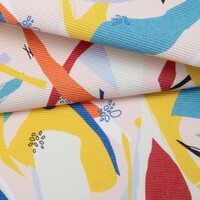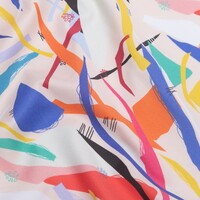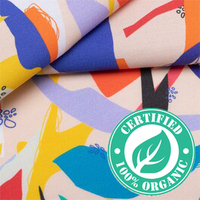Custom Skirt Fabric
Printed Skirt Fabric
from $39.50
There are so many different types of skirts that it can be difficult to know where to start. With custom s...
Read MoreShips In 1 - 2 days
Delivery: $12.95
Handmade
There are so many different types of skirts that it can be difficult to know where to start. With custom s...
Read MoreShips In 1 - 2 days
Delivery: $12.95
Handmade
Some skirts look better with certain fabrics, which is why we have tons of materials to choose from for your custom skirt fabric.
Browse our range of skirt fabrics
Medium weight, soft and stretchy, brushed/knapped face, fire retardant and opaque, matte and fluffy
100% polyester
Medium weight, soft and stretchy, matte, smooth and opaque
90% poly, 10% lycra
Medium weight, shiny and non-stretch, silky, smooth and opaque
100% polyester
Medium weight, soft and stretchy, smooth and matte, opaque
96% polyester, 4% elastane
Heavy weight, soft and stretchy, brushed/knapped face, shiny, fluffy and opaque
98% polyester, 2% elastane
Heavy weight, soft and stretchy, smooth, matte, brushed back and opaque
100% polyester
Heavy weight, soft and stretchy, matte and opaque
97% polyester, 3% elastane
Medium weight, smooth and stretchy, shiny, opaque and silky
85% polyester, 15% elastane
Heavy weight, soft and stretchy, matte, opaque and loop back
100% polyester
Heavy weight, soft and stretchy, brushed/knapped face, fire retardant, shiny, fluffy and opaque
100% polyester
Heavy weight, soft and stretchy, matte opaque and smooth
92% polyester, 8% elastane
Heavy weight, soft and stretchy, matte, smooth and opaque
95% polyester, 5% elastane
Heavy weight, soft and stretchy, matte, smooth and opaque
95% polyester, 5% elastane
Heavy weight, soft and non-stretch, durable, matte and opaque
100% polyester
Light weight, soft and non-stretch, shiny, silky, smooth and opaque
97% polyester, 3% elastane
Heavy weight, soft and non-stretch, durable, matte and opaque
95% cotton 5% linen
Medium weight, soft and stretchy, smooth opaque and matte
82% polyester, 18% lycra
Medium weight, soft and non-stretch, matte and opaque
100% cotton
Heavy weight, soft and non-stretch, matte, opaque and smooth
100% polyester
Heavy weight, soft and stretchy, matte, opaque and smooth
100% polyester
Heavy weight, stiff and non-stretch, soft and opaque, matte
100% cotton
Medium weight, soft and stretchy, matte, opaque
100% polyester
Heavy weight, soft and stretchy, opaque, matte and coarse
94% polyester, 6% elastane
Heavy weight, soft and non-stretch, semi transparent and shimmery
100% polyester
Medium weight, soft and breathable. Quick drying, mesh
100% polyester
325 thread count, high quality bedding material. 100% BCI cotton (Better Cotton Initiative) . Bright white base color, smooth luxury delicate yet durable material. 5-Star hotel bed linen quality. Wide width material at up to 69" print width.
100% cotton
Expected Shrinkage = Weft: 1% Warp: 1%
Organic Cotton Satin with shiny satin face and matte reverse. Sharp print quality and broad color range with rich colours. Woven from organic cotton yarn. Use to create skirts, trousers, dresses, light jackets, and workwear, or light upholstery and kitchen textiles.
100% cotton
Care instructions
Every few washes if you feel the fibers stiffening at all, wait till the fabric is dry then give it a loving brush until you feel it relax and return to its pampered self.






Skirts have been worn for thousands of years since prehistoric times. They are the simplest way to cover the lower half of the body, and in Armenia, there has been a straw-woven skirt discovered that dates back as far as 3,900 BC. The modern skirt comes in a huge variety of shapes and sizes, from the micro skirt to the floor-length skirt. Most frequently, at least in the western world, skirts are worn by women, however, this is not always the case and it is commonplace in some cultures for men to wear skirts. Some fashion designers show men in skirts, and Jean Paul Gaultier frequently adds skirts into his menswear range, famously showing David Beckham sporting his sarong in 2011.
Once you have chosen your skirt material and uploaded your personalized design we will digitally print it in full color, long-lasting print for you. This is done using a variety of methods, depending on your chosen skirt fabric, including pigment printing and dye sublimation. You can also choose from a range of finishing options; have your custom skirt material sent as it comes from the printer, cut on the line with only your design and no white edges, or opt to have your skirt fabric hemmed. One of our seamstresses can hem your textile with either a folded hem using a straight stitch or using an overlocked hem; you can even choose between black and white thread for this. Please note in regards to Cotton Linen that due to the nature of the fabric and our processing methods occasional small white dots may occur. This will not affect the strong colors and detailed nature of your print.
All of our fabrics are printed at 200dpi. This works for us as it combines a great quality as well as a good file weight. In order to avoid resizing and interpolation, we recommend that you scale your image to 100% at 200dpi. Our design interface works with a traffic light system that acts as a quality marker for your designs. This will show you whether the resolution is too low for printing. When you re-upload your design with a highest resolution, the traffic lights will change color, showing you're good to go. A message will pop up alongside the traffic lights to let you know if the resolution is too low or if you have a good quality image.
Your uploaded design will automatically be scaled to fit the size of fabric you've chosen. You can change the dimensions of your fabric by amending the measurements on the ‘Product Options’ tab, under ‘Print Size’. To see how this fits with the dimensions of your image/design, you can refer to the ‘Images & Text Tools’ tab under 'Quality Information'. Here, you will be able to edit the dimensions of the image.
We always recommend using an RGB color space when you upload your images. More specifically, we suggest using the sRGB image profile, to achieve best color results. This will need to be done in your editing software; choose RGB as the working space, and assign the image profile as sRGB (full name sRGB IEC61966-2.1)
There is no length limit for most of our fabrics. Our preview design window is set up to displaying a maximum of 10m (32.8 ft) to help you visualize the print, but that doesn't mean this is the print limit. If you'd like to order more, you can increase the quantity (x2 for 20m or x4 for 40m for example) and order as much as you'd like. Larger volumes will receive an automatic discount too. While the fabric length is nothing to worry about, each individual fabric will have a maximum width side: These can be found on the fabric's page information or in the design interface.
Yes, that will help you when it comes to cutting or framing your printed fabric. We recommend always adding a little extra space for borders into your purchased fabric size. When we print your materials, or send out fabric samples, we typically trim squarely around the fabric, leaving approximately 5mm white space. Cutting neatly on the line has an additional fee.
Crocking is the term used to describe fading along the creases in a fabric. It typically can occur after constant washing or heavy use of digitally printed natural fabrics. Crocking can be minimized by hand washing your fabrics at a cooler temperature, rather than machine washing. If you want to make sure there's no chance of crocking, we'd suggest you use a poly fabric.
Yes, our organic fabrics don't have an additional coating like non-organic fabrics have, which means it absorbs the inks deep into its fiber and reducing the color strength slightly (this can be approximately -40%). If you would like a bolder, more vibrant color for your fabric, we would suggest using a non-organic fabric.
Unfortunately not; all of our fabrics have been tested meticulously to ensure we know exactly how to get the best results, and our facilities cater perfectly to them. If you are set on a fabric we don't offer, we can offer custom printed sublimation paper to order which will allow you to heat press your designs onto your own fabrics.
If your design is simple and less intricate, a JPEG will be absolutely fine. However, if you have created a design with multi-colored detailing, we would recommend saving your design in a TIFF format.
Similar to other fabric printing processes, shrinkage can occur. The amount of shrinkage will depend on the fabric, but as a general rule of thumb, please allow for 2-8% shrinkage when working out your measurements. Shrinkage is not an exact science, and the amount of shrinkage will vary from print run to print run. We'd always suggest order a little more than you need for your project.
Many of the fabrics we offer are semi-transparent, so printing on both sides of the fabric is not a service we offer.
At the moment, all of our fabric labels are printed on satin fabric. For now, we believe this is the best choice, but will potentially introduce other options in the future. All labels are cut to the same label format. If you would like to choose a different fabric and format for your labels, you could always order a sheet of the fabric of your choice to create labels yourself.
Our fabrics are printed with water-based inks as environmental consciousness is always front of our minds. Water-based inks include no chemicals or solvents, and our printing process uses heat to fix colors and patterns into place to avoid excess or contaminated water returning into the water system (this is something that can occur through steaming). All printing, fulfilment and production is done in our one facility, and rather than rolling the fabrics or sending them in a tube, you will receive your material folded up. This amounts to 150 tubes saved a week, as well as much more space on the delivery van for more orders. (For delicate fabrics we ensure to package appropriately).
Although very rare, there could be a slight color difference from one print run to another. This is a normal part of the printing process, however we are always working to improve our color profiles. It is unlikely that the difference in print runs will be hugely different (for example, it's unlikely your orange is suddenly going to be red). The likelihood of color variations can be intensified fabric to fabric due to materials having different grains and textures; natural fabrics typically have more muted color tones, while poly alternatives have a bolder hue. This is because the construction of the material is different, and the printing method has to be altered slightly for more delicate, natural textiles.
Our full cut & sew service at Bags of Love can be used to your full advantage. We even offer hemming for your fabrics at a small additional cost. Our hems are created with a one or two cold hem that typically uses around 5 to 20mm of fabric (depending on the thickness of your chosen material). Please bare this in mind when you are ordering your printed fabric with hems: If you would like your finished piece to be 40" x 40", change your dimensions to 41" instead to allow space for your hems (you will also need to include additional for potential shrinkage). The thicker the fabric, the bigger the hem will be. Your printed fabric will be hemmed with either Black or White thread. If you are ordering a lightly woven material or a printed silk, you will find that one hem will be straight, while the other slightly rippled. The hemming material allowances are as follows and you need to make your print bigger to accommodate the hem:
For further information about our fabrics see our FAQs.
Please note: As everything we provide is handmade to order, you may find a slight variance in the sizes.






